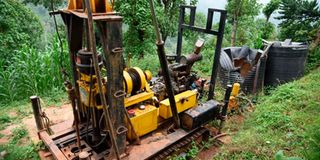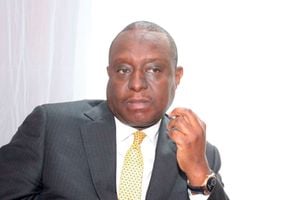
Abandoned equipment at Kipsaiya in Elgeyo Marakwet where Arror dam was to be built.
New details emerging from a clause-by-clause analysis of the financing agreements under which billions of shillings appear to have been siphoned from the public purse through loans to finance the stillborn Kimwarer and Arror dams show that the taxpayer will continue to service the expensive loans until 2035.
Despite the Kenyan government insisting the deal was above board and the projects would be implemented, close scrutiny of the contracts reveals a tale of how European lenders seem to collude with State actors to craft financing schemes whose effect is to saddle the books of African governments with massive debt service.
The Weekly Review has seen the loan contracts that have been treated by the government as deep dark secrets since they were negotiated and signed in 2017.
As a matter of fact, even the Auditor-General has been lamenting in successive reports about how the agreements had been kept secret under the excuse that they were in the custody of the Directorate of Criminal Investigations as the matter was in court.
In her latest report for the year ending June 2023, the OAG continues to lament, pointing out that the agreements were still kept away from her even after the court case had ended.
The OAG’s position is that she needs to audit the deals to confirm the terms of the loans and to determine whether a recent decision by the European lenders to terminate the loans imply that Kenya has been absolved from all obligations under the contract.
The Weekly Review can today reveal details of the secret loan agreements.
The first telling revelation from the scrutiny of the contract documents are clauses that legally delink and separate the loan agreements from the construction of both Arror and Kimwarer dams.
For example, under Clause 2.4(a) of the contract, the ‘borrower’s obligations’ are stated as follows: “The obligations of the borrower under the agreement constitute absolute, unconditional and irrevocable obligations to the lender.”
Sovereign debt space
It continues: “Such obligations are independent and separate obligations regardless of whether the parties to the commercial contract have performed their respective obligations under the commercial contract.”
Put in plain English, this is what these clauses say: “You owe the money whether or not a dam is built. Your obligation to pay me is separate and independent from performance on the dams.”
Indeed, a scrutiny of the loan contracts reveals an illuminating case of the emergence and high-profile presence in the sovereign debt space in Africa of European lenders and rogue arrangers who thrive in reaping rents through unorthodox financing schemes and arrangements.
Although the loan is often touted by government spokesmen as a government-to-government deal, the irrefutable evidence from the contract documents is that this was a pure commercial syndicated loan.
On the front page of the loan document, all of the four lenders are listed as both ‘lenders and arrangers’. They are BNP Paribas Fortis SA/NV, Intesa Paolo SPA, Unicredit SPA and Unicredit Bank AG.
Intesa Paolo SPA, London branch, is listed as the agent of the financing parties. Going through the documents, what strikes you is the sloppiness with which the signature pages are done.
Because of the risks involved in commercial lending to sovereigns, the conventional practice is that the signature pages are signed by a senior bank official with the status to commit a lender on a large sovereign borrowing.
Curiously, the titles and positions of the individuals signing for the four lenders are not indicated. The names are hand-written and the signature pages are not dated. A lady by the name Maria Semioni signed for Intesa Paola, Stefano Leo (BNP Fortis Paribas SA/NV), Danielle Di Mario (Unicredit SPA), and Bridgit Dollman and Peter Haitzinger (Unicredt AG).
Having signed a lopsided deal in their favour, the lenders proceed to open two loan facilities denominated in Euros – €258.6 million – ostensibly to fund Kimwarer dam, and another, €319.6 million, in the name of funding Arror dam, at Intesa Sao Paolo Bank on the address: 90 Queen Street, London, EC4N 1SA.
In reality, this was more or less an overdraft facility. Under the agreement, money could only come out of this account by Kenya issuing a duly completed utilisation notice.
The agreement also says that money was to be directly disbursed into a bank account outside the borrower’s country.
Put plainly, the deal was as follows: You have a facility. You can use it. But no money comes to your country. Documents show that one of the very first withdrawals from this account was effected through a utilisation notice dated December 22, 2017 for €52 million, signed by a former director of resource mobilisation at the National Treasury, Mr Jackson Kinyanjui. That was paid directly, and went into paying insurance premiums and into an account belonging to the Italian state-owned export credit insurer, SACE, at an Italian bank called Banca Popolare di Sondrio.
External debt register
Under another utilisation notice reference Number MOF/ERD/20/94/78/01/(63), €36.8 million was paid directly to an account belonging to CMC di Ravenna-Itinera on December 22, 2017. On November 6, 2018, a utilisation request reference NT/RMD/MOF/KIM/20/90/78 effected direct payment of €29.7 million to an account at Intesa Sao Paola belonging to CMC di Ravenna-Itinera.
Although The Weekly Review has not seen all the withdrawals that were made from this account, the official government record as per the latest external debt register published on the website of the National Treasury is that out of the €577 million facility, €334 million was drawn from the account.
The scenarios beg the following questions. Where did the billions go since there are no dams and considering that all of the money from the account was flowing into foreign bank accounts?
Why were we paying CMC di Ravenna-Itinera when the company did not lift as much as a spade in clearing bushes?
In retrospect, the Italian entities covered their backs well by introducing clauses in the loan contract that did not tie the agreement to performance. What was crafted resembled a deal hatched to facilitate an elaborate money laundering scheme.
Perhaps the most opaque area in the whole arrangement is the role of SACE, the Italian export credit agency.
The very first time the name of the export credit insurer is mentioned in the loan contracts is when the contract discloses that “the lenders will have the benefit from an insurance policy issued by SACE”.
The agreement also states that “SACE agrees to insure the borrower’s obligations under this agreement”.
At this stage, the assumption is that SACE’s role in this deal is analogous to that of the Chinese entity, Sinosure, in similar contracts.
Yet, in the next pages, the insurer suddenly morphs into a lender under a “total SACE facility commitment amounting to €222.6 million”.
The riddle is compounded by the fact that the entity – unlike China Eximbank and several other export credit organisations – is not listed as a lender on Kenya’s external debt register.
Legally, the insurance arrangement can pass. But the moral question is the following: Why were we paying billions for loans that gave us no assets?







